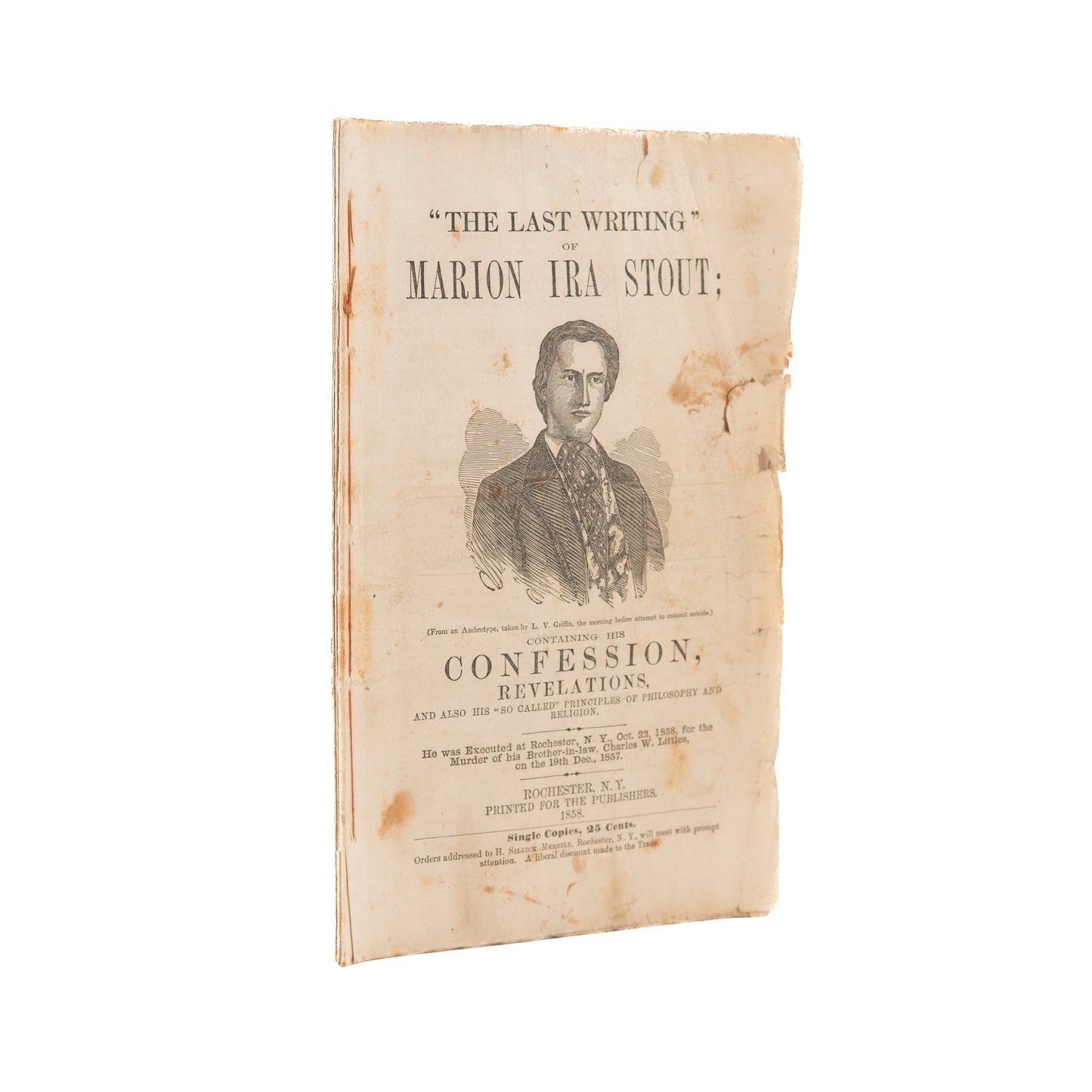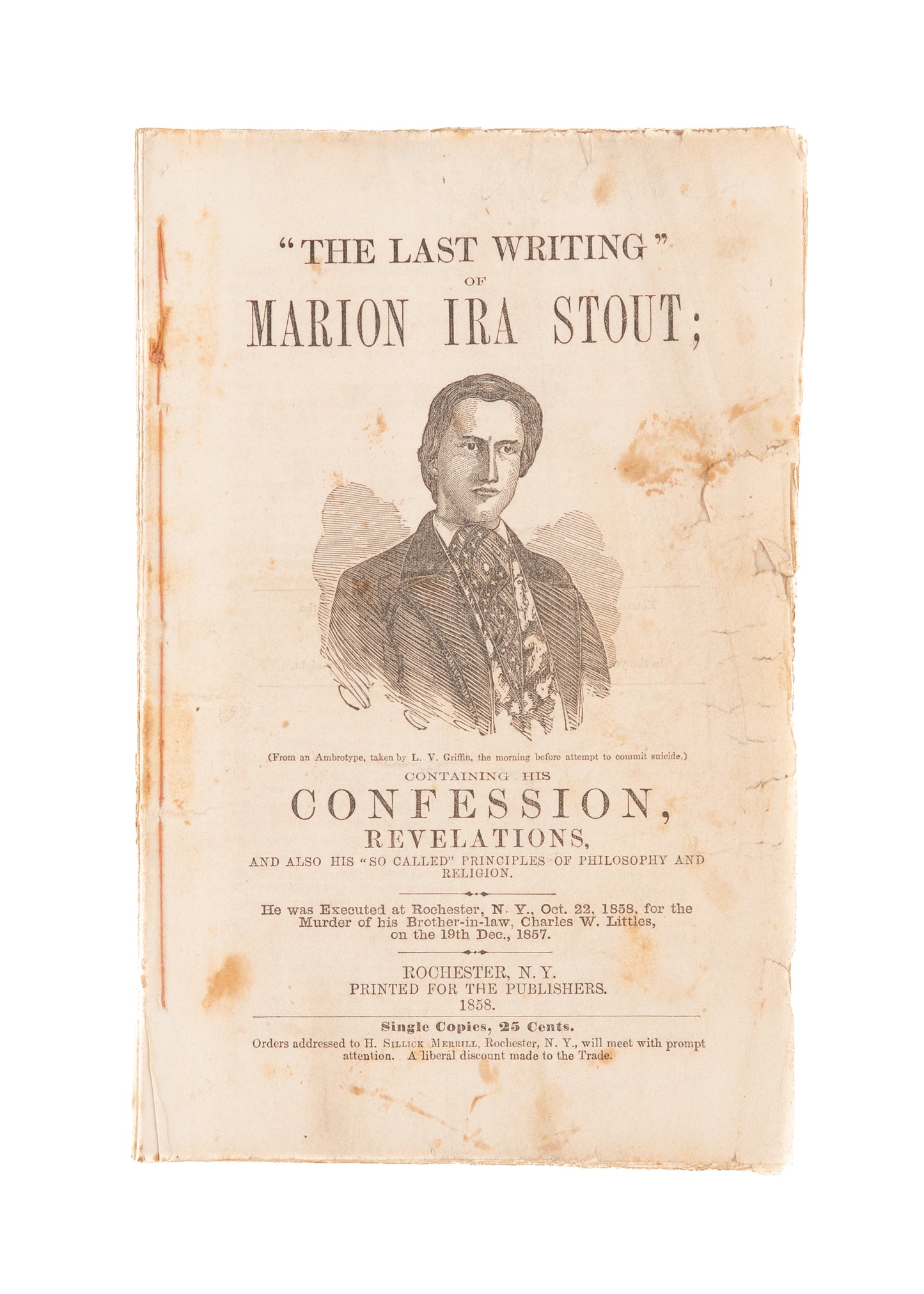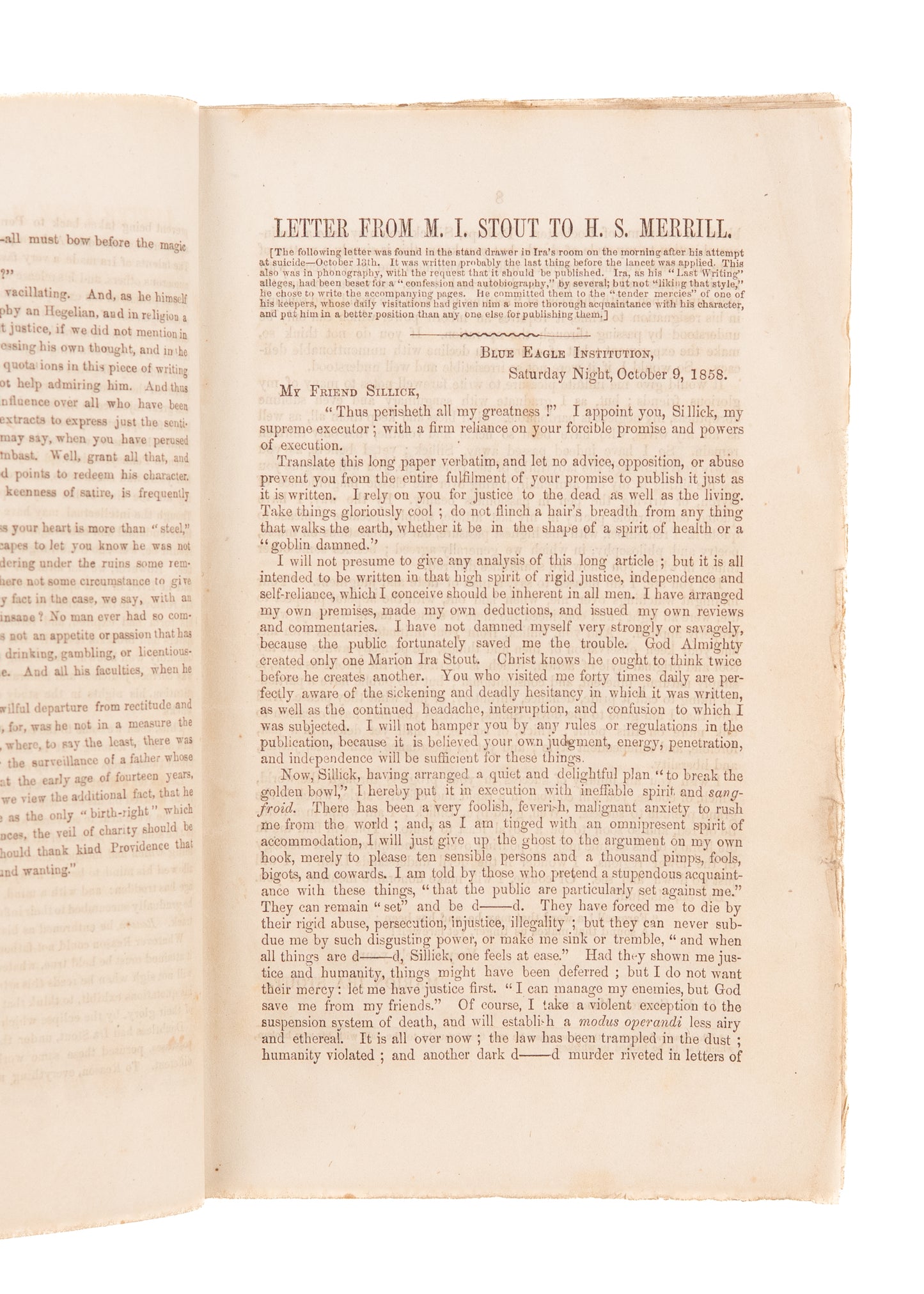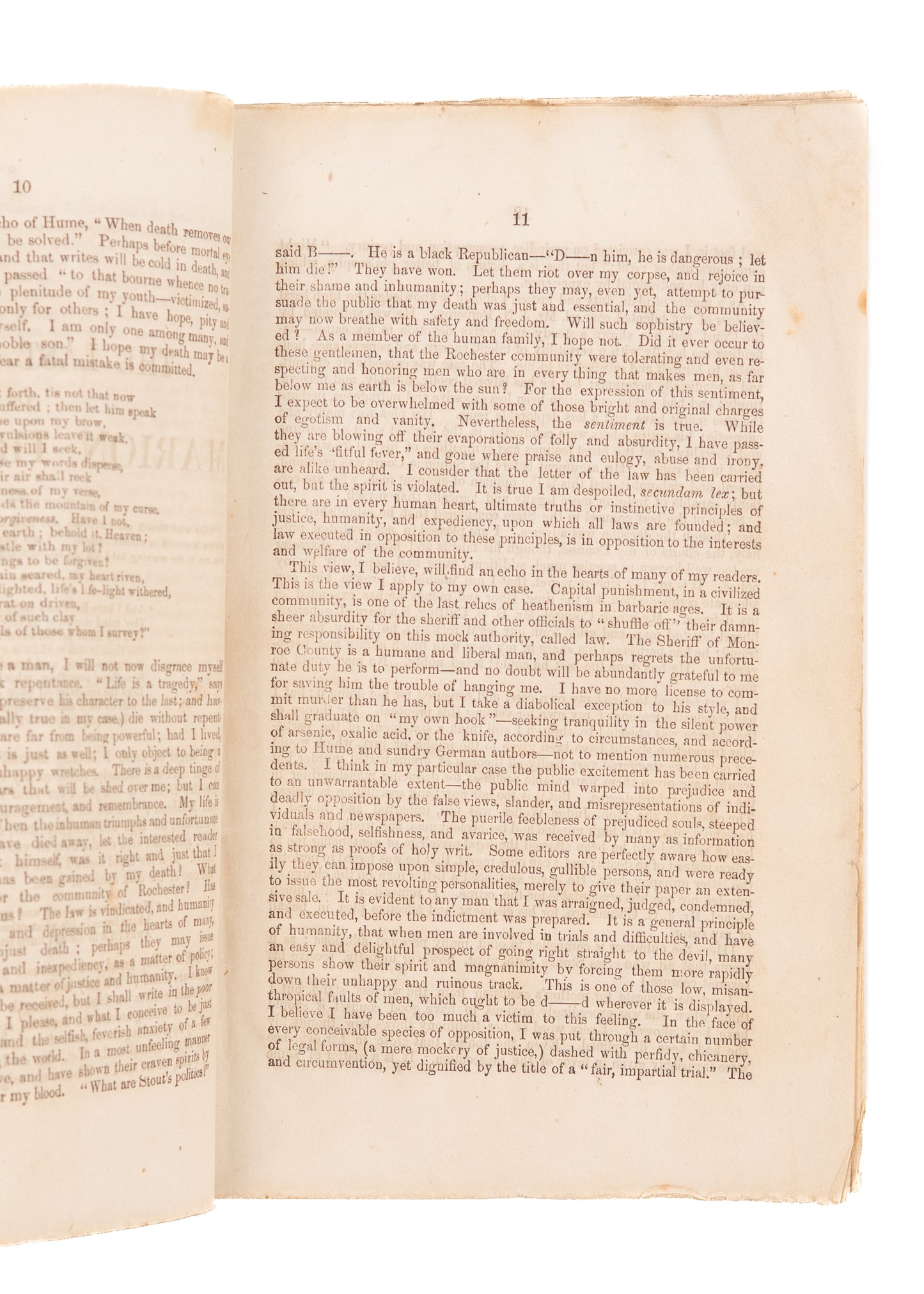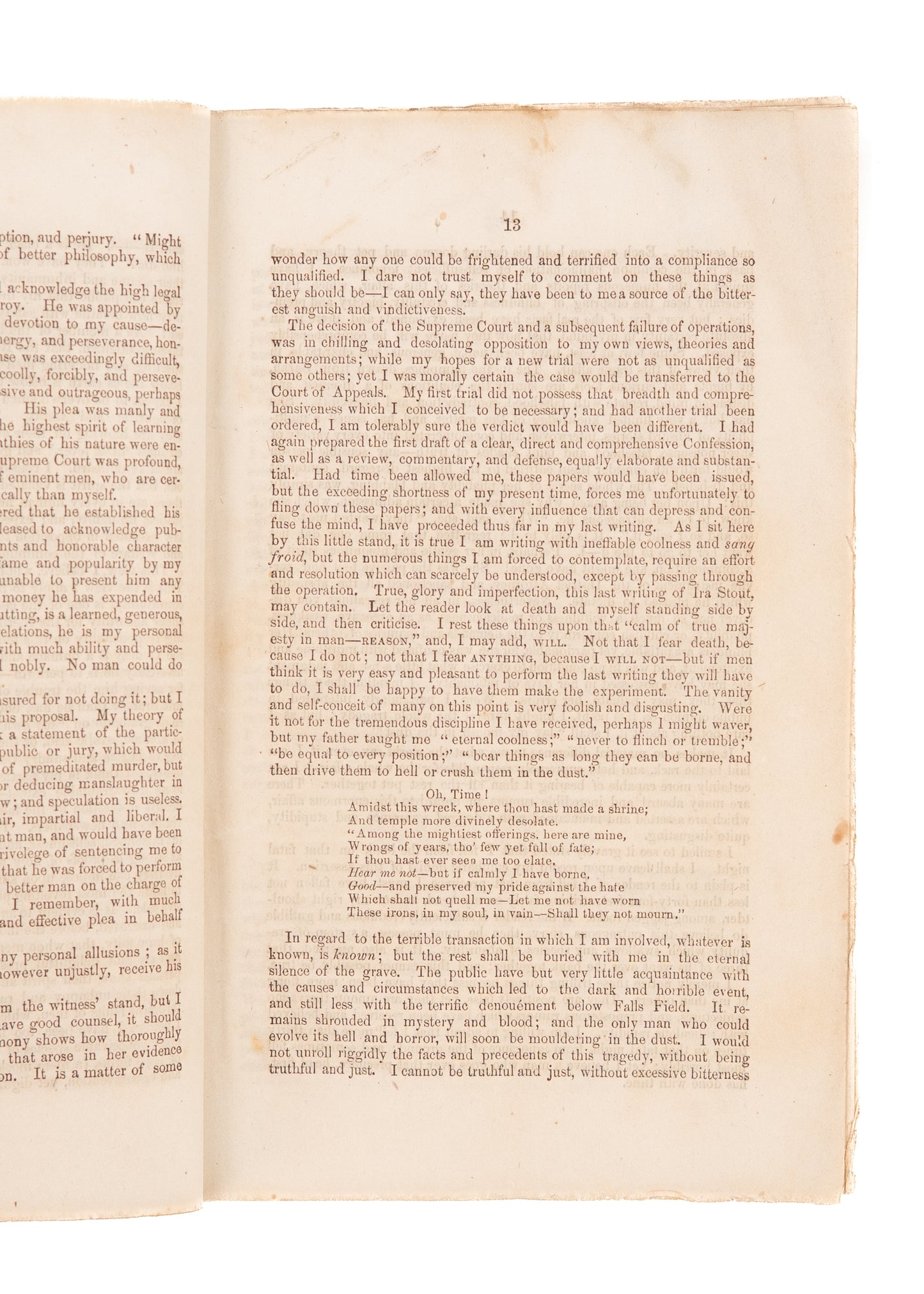Specs Fine Books
1857 MARION IRA STOUT. "The Last Writing" of Marion Ira Stout. Hanged for the Murder of His Family.
1857 MARION IRA STOUT. "The Last Writing" of Marion Ira Stout. Hanged for the Murder of His Family.
Couldn't load pickup availability
A very scarce and fascinating piece of macabre Americana.
One of most sensational murder trials of the 19th-century was that of Marion Ira Stout, who was hanged on October 22, 1858 for the murder of Charles Littles.
The Stout family had lived in Rochester, New York since 1852. Accounts of the time ring true still. He was "quiet," "kept to himself," etc., Eli Stout, Ira's older brother and head of the family, lived with his mother Margaret, his wife Jane, his younger sister Sarah and her husband Charles Littles, in a house at 75 Monroe Street.
Margaret Stout, the family matriarch, often claimed her husband, Orange Stout, had abandoned the family and that she was unsure of his whereabouts. The truth was more likely that he was "on the lamb." Members of the Stout family were often in trouble with the law.
Orange was a known member of a gang of forgers and counterfeiters. Both husband and wife had been previously arrested for passing counterfeit money. At the time of his son's murder trial, Orange Stout was serving a 7-1/2-year sentence in Auburn State Prison for his part in robbing and burning down a retail store in Pennsylvania.
Ira [the name he preferred] himself also admitted participation in the crime and he received a 4-1/2-year sentence also in the Pennsylvania State Penitentiary. When Ira Stout was released from prison in August 1858, he settled back in with his family.
It quickly became apparent to Ira that the marriage between his sister Sarah and her husband, Charles Littles, was disastrous. Charles was apparently a very public and repeated philanderer and was suspected of illegalities. As a result, Sarah had become depressed and looked to her brother Ira for emotional support. She blamed all of her problems on Littles, and even considered moving west to escape from him.
Ira suggested that "if Littles should some time be put out of the way, there would be no need of her going west to get rid of him!"
Ira also had his own reasons to fear his brother-in-law and hasten his departure from the scene. Only his own family and Littles were privy to the knowledge of Ira's recent imprisonment. Eager to gain respectability, Ira worried that Littles could destroy his standing by making this knowledge public. To allay his fears, Ira sought to establish a friendship with him. Ira called frequently at his office and the two men were often seen playing pool together.
All the time, he secretly despised Littles for the way he treated Sarah. Ira and Sarah grew closer through the situation and, it was accused, this led to seemingly sustainable accusations of the incest which provided a part of the motive for murder at trial. By the account of multiple family members, Ira and Sarah were seen together repeatedly in the same bed in a "state of undress." Several family members testified to this. Eli Stout's wife, Jane, who also lived in the same house, testified at the trial she often saw Ira and Sarah in bed together.
Ira was enraged at Littles' mistreatment of Sarah's, writing later that "a man who would abuse a pure and beautiful woman, is not fit to live." He vowed to "do away" with Charles W. Littles, once and for all.
The plan for the murder was straightforward. Late at night, Ira would lure Littles to Falls Field, on the north side of High Falls, on the false pretext that Sarah was going to meet another man. Once there, Ira would hit Littles on the head with a hammer and throw him into the gorge allowing the strong current to sweep his body down river and into the lake.
Unfortunately for Ira and Sarah, everything went horribly wrong. When Ira had Littles in the proper position near the edge of the bank, Ira struck him a sudden blow with an iron mallet, smashing his skull and killing him instantly. Stout then threw the body over the wall, supposing that it would fall into the river and be swept into the lake, but instead, it landed on a ledge thirty feet below the upper level. Sensing that there had been some failure in the matter, Ira started to go down a narrow path that led sideways along the cliff, but in the darkness he missed his footing and fell headlong, breaking his left arm in the descent and landing beside the corpse. Summoning all his remaining strength he was just able to push the body over the bank, when he fell into a dead faint.
The body of Charles Littles was discovered the following morning by a group of young boys, floating in the river with the hapless and unconscious Ira lying not a few feet away.
Ira was subsequently charged with the murder of Charles Little. His trial began in April and lasted only a week. On April 24, the jury rendered a unanimous verdict of guilty and sentenced him to hang. The day of the hanging soon came. Ira said his final goodbyes to his family. At 2 p.m., he was led to the gallows. In the presence of 100 invited dignitaries, the rope was placed around his neck and a cap drawn over his face. The Union and Advertiser described what happened next:
" . . . All being ready and the spectators standing in breathless silence , at twenty minutes past three o'clock Sheriff Babcock pulled the fatal line, and Ira Stout was suspended three feet from the floor. Not a sound was heard in any direction, save the heavy fall of the weight which did the fatal work. The death of the ill-fated man was not as sudden as could be desired though. He struggled for eight or ten minutes and caused the spectators to turn away in disgust. His neck was probably not dislocated, and he most probably died by slow strangulation."
Ira was laid to rest in an unmarked grave in Section D of Mount Hope Cemetery where, curiously, he lies directly beside another of Rochester's most infamous killers, Octavius Barron, the murderer of William Lyman."
Stout, Marion Ira. "The Last Writing" of Marion Ira Stout; Containing his Confession, Revelations, and also his "So Called" Principles of Philosophy and Religion. He Was Executed at Rochester, N. Y. , oct,. 22, 1858, for the Murder of his Brother-in-Law, Charles W. Littles, on the 19th of Dec., 1857. Rochester. Printed for the Publishers. 1858. 38pp.
A good "soft" copy, bound in wraps. Lightly shaken with light foxing, handled pages with tears and folds at extremities.
Share
